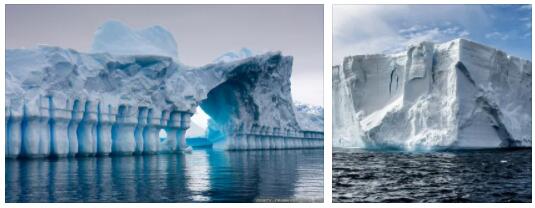Antarctica is an ice-covered continent located at the south pole of the Earth, with an area of about 14.1 million km2. From the Greek “Antarctica” means “a place opposite to the Arctic”. The mainland is almost 2 times the size of Australia and 1.4 times the size of Europe. The ice shelves of Antarctica, with a total area of 0.93 million km2, represent 1/15 of the entire territory of the continent and are the source of the largest icebergs on the planet. The continent includes the mainland Antarctica and the islands adjacent to it (South Shetland Islands, Alexander Island, Peter I Island, Anvers Island, Adelaide Island, etc.). The mainland is divided into territories (“lands”) named after their discoverers and historical figures, for example: Kemp Land, Macrobertson Land, Princess Elizabeth Land, Coates Land, Ellsworth Land, Wilhelmem Land, etc. Only 3-4% of the area of Antarctica (40 thousand km2) is free from ice cover, these are sections of islands and coasts, “Dry Valleys”, ridges and peaks of the transantarctic mountains (they are also called “nunataks”). The thickness of the ice dome of Antarctica is on average 2600 meters; these ices contain the world’s fresh water supply (about 80% of all fresh water on Earth). Thanks to the ice cover, the mainland rises 2000 meters above world sea level. Antarctica was discovered by a Russian scientific expedition in January 1820, its supervisors were Mikhail Lazarev and Thaddeus Bellingshausen. Since then, for almost two centuries, scientists from different countries have been constantly studying Antarctica. More than 45 scientific stations from various countries of the world have been built here, including Russia, the USA, China, Japan, Germany and Chile. Among the Russian scientific facilities in Antarctica currently operating: Vostok, Novolazarevskaya, Mirny, Bellingshausen and Progress, two more stations are reserved. Antarctica is recognized as a free zone for scientific research. According to the settlement agreement of December 1, 1959, Antarctica cannot belong to any country. On the territory of the mainland, the deployment of military strategic facilities, nuclear power units and other nuclear carriers is prohibited. Every 50 years, this agreement is reviewed, in 2009 the meeting of countries decided to leave the convention unchanged. Interest in the study of the icy continent is growing as the need for new sources of energy resources grows, which, according to experts, abound in Antarctica. According to polar scientists, rich sources of oil are concentrated in the bowels of the mainland, gas, precious metals, coal and charcoal. The development of such deposits requires colossal funds, and scientists from the United States and China are working most actively in this direction today.
Geography of Antarctica
The center of the mainland coincides with the geographic south pole of the earth. Antarctica is washed by the waters of the Atlantic, Indian and Pacific oceans. The waters surrounding Antarctica are also called the Southern Ocean, its area is conditionally determined within 20 million km2. The continent includes the mainland Antarctica, the Antarctic Peninsula and nearby islands. The entire territory of the mainland is riddled with subglacial rivers and lakes.
Capital Area
The area of Antarctica is 14.1 million km2. sq.
Population
1000-4000
Currency Language
Population of Antarctica
Due to the cold climate, there is no permanent population in Antarctica. Research stations operate here in winter and summer, about 1,000 people are employed on the continent in winter, and about 4,000 people in summer. Every year tourists visit the continent, in 2010 their number was 36,000 people. It is noteworthy that in 1978 a human child was born on the mainland for the first time, this happened at the Esperanza station, where the Argentine Emilio Marcos Palma was born. In 2004, on about. Waterloo was consecrated the first Orthodox Church in Antarctica – the Church of the Holy Trinity. In 2007, the first wedding ceremony in Antarctica was performed here, the priest blessed the marriage of Eduardo Aliaga Ilabac (a scientist from Chile) and Angelina Zhuldybina (daughter of a Russian researcher).
Weather in Antarctica
Antarctica is characterized by severe climatic conditions with low temperatures, strong winds (katabatic winds, the speed of which reaches 300 km / h), snow storms and fogs. It never rains here, and the humidity is almost zero. In the Eastern part of the continent in 1983, the lowest temperature in the history of meteorological observations was set, minus 89.2 Celsius. Winter here lasts from June to August, with an average temperature of -60 to -70 degrees, in summer (December, January, February) – from -30 to -50 degrees. On the coast of Antarctica, the temperature is much higher than the average for the mainland, in winter the thermometer here shows from -8 to -35 degrees, and in summer – from 0 to -5 degrees. The tourist season to Antarctica opens in November-December and ends in March-April.
